Section A 第1课时(导学案)8
新人教Unit_8_Is_there_a_post_office_near_here导学案
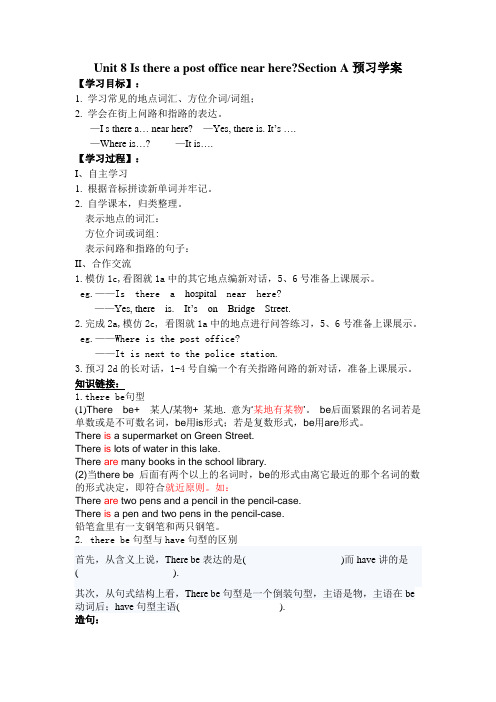
Unit 8 Is there a post office near here?Section A预习学案【学习目标】:1. 学习常见的地点词汇、方位介词/词组;2. 学会在街上问路和指路的表达。
—I s there a… near here? —Yes, there is. It’s ….—Where is…? —It is….【学习过程】:I、自主学习1. 根据音标拼读新单词并牢记。
2. 自学课本,归类整理。
表示地点的词汇:方位介词或词组:表示问路和指路的句子:II、合作交流1.模仿1c,看图就1a中的其它地点编新对话,5、6号准备上课展示。
eg.——Is there a hospital near here?——Yes, there is. It’s on Bridge Street.2.完成2a,模仿2c, 看图就1a中的地点进行问答练习,5、6号准备上课展示。
eg.——Where is the post office?——It is next to the police station.3.预习2d的长对话,1-4号自编一个有关指路问路的新对话,准备上课展示。
知识链接:1.there be句型(1)There be+ 某人/某物+ 某地. 意为‘某地有某物’。
be后面紧跟的名词若是单数或是不可数名词,be用is形式;若是复数形式,be用are形式。
There is a supermarket on Green Street.There is lots of water in this lake.There are many books in the school library.(2)当there be 后面有两个以上的名词时,be的形式由离它最近的那个名词的数的形式决定,即符合就近原则。
如:There are two pens and a pencil in the pencil-case.There is a pen and two pens in the pencil-case.铅笔盒里有一支钢笔和两只钢笔。
八年级英语上册第一单元Section A第一课时(导学案)
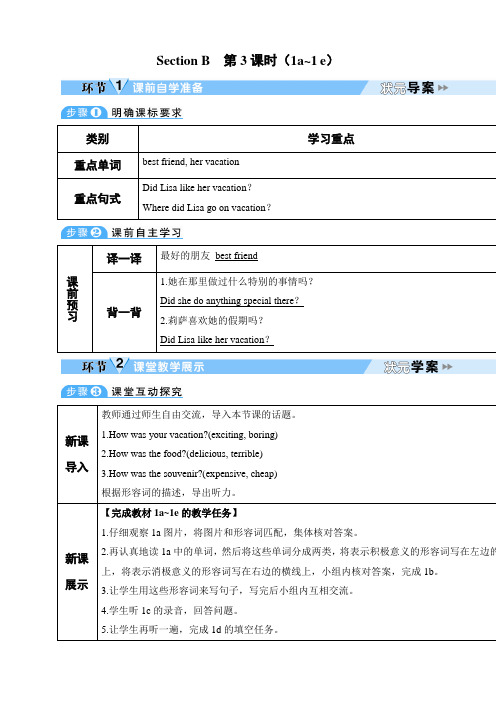
类别
学习重点
重点单词
best friend, her vacation
重点句式
Did Lisa like her vacation?
Where did Lisa go on vacation?
课前预习
译一译
最好的朋友best friend
背一背
1.她在那里做过什么特别的事情吗?
—But traveling becomes much easier!
A. convenient B. expensive C. difficult D. trendy
布置作业:教师引导学生课后完成本课时对应练习,并预习下一课时内容。
教学反思
在本课的学习中可以配以图片或者做小游戏,既加深了学生对所学单词的记忆,也丰富了课堂形式。还可以让学生依据材料,自由组合进行问答对话,进一步地强化了学生的口头表达能力
【语法提要】
cheap与inexpensive
二者都表示“便宜的”。cheap往往意为质量差,指价钱便宜的或因质量差而价格低的。inexpensive指物美价廉的,价值与价格相比而便宜,表示“价格公道的;不贵的”。
例句:The clothes in the shop are very cheap.这个商店的衣服非常便宜。
This kind of car is inexpensive.这种汽车便宜。
【问题探究】
(A)1.Where did Kim ____ vacation?
A. go on B. go in C. go to D. went on
(A)2. Jim is a boy _____brown hair.
3.让学生用这些形容词来写句子,写完后小组内互相交流。
2012版新目标英语七年级下册Unit_8_Is_there_a_post_office_near_here导学案
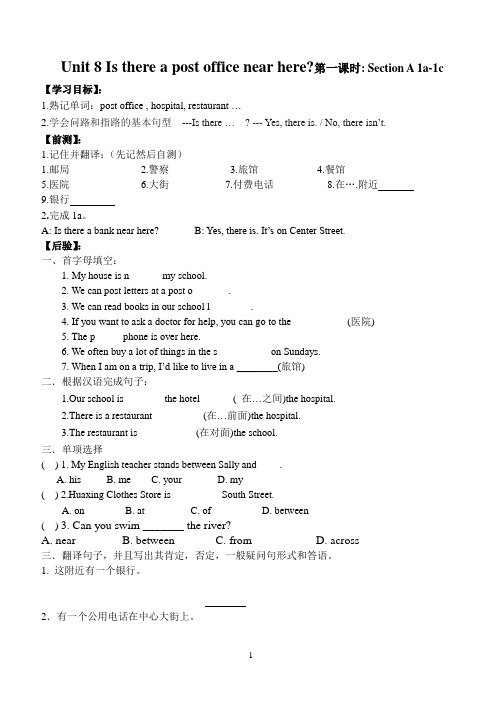
Unit 8 Is there a post office near here?第一课时: Section A 1a-1c 【学习目标】:1.熟记单词:post office , hospital, restaurant …2.学会问路和指路的基本句型---Is there …? --- Yes, there is. / No, there isn’t.【前测】:1.记住并翻译:(先记然后自测)1.邮局___________2.警察_________3.旅馆___________4.餐馆_________5.医院____________6.大街________7.付费电话__________8.在….附近9.银行2.完成1a。
A: Is there a bank near here? B: Yes, there is. It’s on Center Street.【后验】:一、首字母填空:1. My house is n______ my school.2. We can post letters at a post o_______.3. We can read books in our school l________.4. If you want to ask a doctor for help, you can go to the___________(医院)5. The p_____ phone is over here.6. We often buy a lot of things in the s__________ on Sundays.7. When I am on a trip, I’d like to live in a ________(旅馆)二.根据汉语完成句子:1.Our school is _______ the hotel ______( 在…之间)the hospital.2.There is a restaurant__________(在…前面)the hospital.3.The restaurant is ___________(在对面)the school.三.单项选择( ) 1. My English teacher stands between Sally and ____.A. hisB. meC. yourD. my( ) 2.Huaxing Clothes Store is _________ South Street.A. onB. atC. ofD. between( ) 3. Can you swim _______ the river?A. nearB. betweenC. fromD. across三.翻译句子,并且写出其肯定,否定,一般疑问句形式和答语。
八年级英语导学案课题:Unit 8 How do you make a banana milk shake?Section A 1a-1c
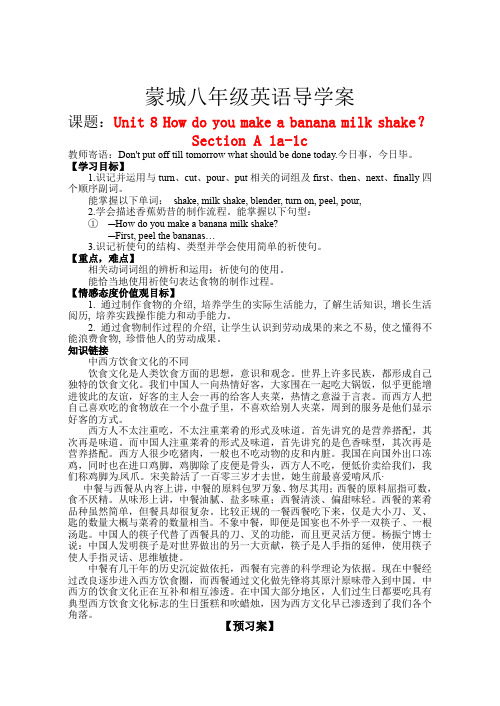
蒙城八年级英语导学案课题:Unit 8 How do you make a banana milk shake?Section A 1a-1c教师寄语:Don't put off till tomorrow what should be done today.今日事,今日毕。
【学习目标】1.识记并运用与turn、cut、pour、put相关的词组及first、then、next、finally四个顺序副词。
能掌握以下单词:shake, milk shake, blender, turn on, peel, pour,2.学会描述香蕉奶昔的制作流程。
能掌握以下句型:①─How do you make a banana milk shake?─First, peel the bananas…3.识记祈使句的结构、类型并学会使用简单的祈使句。
【重点,难点】相关动词词组的辨析和运用;祈使句的使用。
能恰当地使用祈使句表达食物的制作过程。
【情感态度价值观目标】1. 通过制作食物的介绍, 培养学生的实际生活能力, 了解生活知识, 增长生活阅历, 培养实践操作能力和动手能力。
2. 通过食物制作过程的介绍, 让学生认识到劳动成果的来之不易, 使之懂得不能浪费食物, 珍惜他人的劳动成果。
知识链接中西方饮食文化的不同饮食文化是人类饮食方面的思想,意识和观念。
世界上许多民族,都形成自己独特的饮食文化。
我们中国人一向热情好客,大家围在一起吃大锅饭,似乎更能增进彼此的友谊,好客的主人会一再的给客人夹菜,热情之意溢于言表。
而西方人把自己喜欢吃的食物放在一个小盘子里,不喜欢给别人夹菜,周到的服务是他们显示好客的方式。
西方人不太注重吃,不太注重莱肴的形式及味道。
首先讲究的是营养搭配,其次再是味道。
而中国人注重莱肴的形式及味道,首先讲究的是色香味型,其次再是营养搭配。
西方人很少吃猪肉,一般也不吃动物的皮和内脏。
我国在向国外出口冻鸡,同时也在进口鸡脚,鸡脚除了皮便是骨头,西方人不吃,便低价卖给我们,我们称鸡脚为凤爪。
七年级英语上册Unit8Whenisyourbirthday?导学案新版人教新目标版
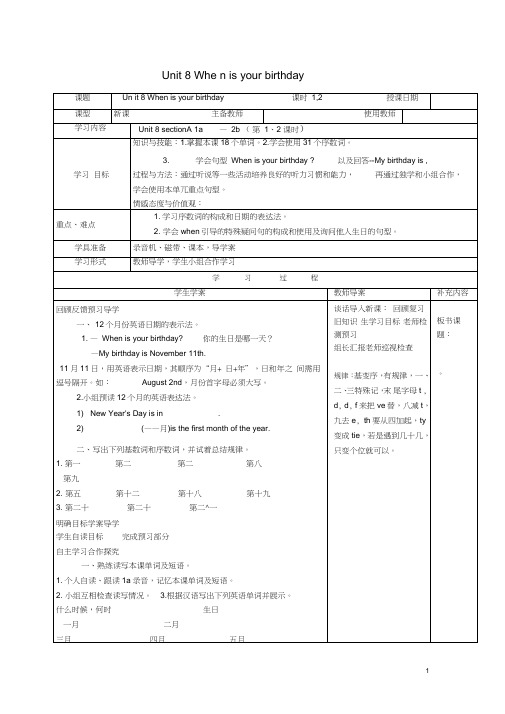
school
day校庆
二、练习听力
日school trip学校组
1.听录音完成2a。
织的旅行volleyball
game排球比赛
2.再听一遍,
完成2b内容。
3.在
某一天用
介词
展示提炼拓展延伸
.在某一天的上午/
用所给单词的适当形式填空。
下午/晚上用介词
5
1. When is
birthday ? ( Jeff )
Unit 8 sectio nB1a—3a (
第4课时)
知识与技能:1.掌握词汇basketball game,birthday party
English test,art
festival,school day,school trip
,soccer game
学习
2.熟练掌握句型When is-
--? It's ---.
5.8月15日6.9月10日
7.10月12日8.12月25日
达标测试效果反馈
一、单项选择。
()1.When is your birthday? It's.
A.FebruaryB.second
C.February seco ndD.1990
()2.Themonth of the year is April.
A.When B.When old C.How old D.How
()8.Happy Birthday to you !.
A.That's all right B.The same to you.C.Tha nk you D.That's OK.
课时
3
授课日期
新人教版九年级英语unit8导学案

Uni..It must belong to Carla........Part One (Section A 1a ---- 2d)一、课前自学(3min)1.完成1a表格填写。
2.翻译完成下列短语。
属于可能是用完,用光在野餐中她最喜欢的作家这是谁的笔记本?它可能是Carla的。
二、探究、展示(25min)1.要求学生翻开课本P57, 迅速浏览所给的图片, 然后把图片中所给的物品填入到所给的栏目中。
2.检查答案, 先要求全班一起给出答案并检查讨论。
然后要求2-3名同学就图片中所给的物品, 使用“Whose volley is this?”句型, 给出各自的答案。
1b的听力任务。
4.要求学生听第二遍录音, 并逐句进行跟读。
5.完成教材1c的任务, 要求学生根据上面所给的图片, 使用1b表格中的信息编写对话进行练习, 然后要求2-3位学生上台表演。
6要求学生翻开课本P58。
要求学生听第一遍录音, 完成2a, 2b的听力任务。
7.要求学生听第二遍录音, 并逐句进行跟读。
8.大声朗读听力材料。
9要求学生模仿2c方框的对话, 利用2a, 2b提供的信息, 编造自己的对话, 然后演练。
10.2d的对话录音, 让学生跟读, 模仿并理解大意。
然后让学生分角色朗读并表演2d的对话。
三、点拨(7min)1.动词表推测时的用法区别:must, might, could, can’t, may2.课所涉及到的短语四、当堂训练(5min)汉译英, 每空一词。
1)这一定是王斌的, 上面有他的名字。
It Wang Bin’s.It has his name on it.2)这个篮球是属于鲍勃的。
The basketball3)你听古典音乐吗?Do you listen to4)这是谁的自行车?is this?( )1 —Let’s go to the market by taxi. —We___ take a taxi. It is not too far from here.. A.can’t . B.needn’t ..C.couldn’t . D.mustn’t( )2 “May I try on the jeans?”“Yes, you_____”A. should .B.can .C.must .D.need( )3 When traffic lights are red, we ___stop and wait.A. may ..B. can .C.must .D.mightPart Two (Section A 3a—3c)一、课前自学(3min)翻译完成下列短语。
仁爱英语八年级下册Unit8Topic1导学案
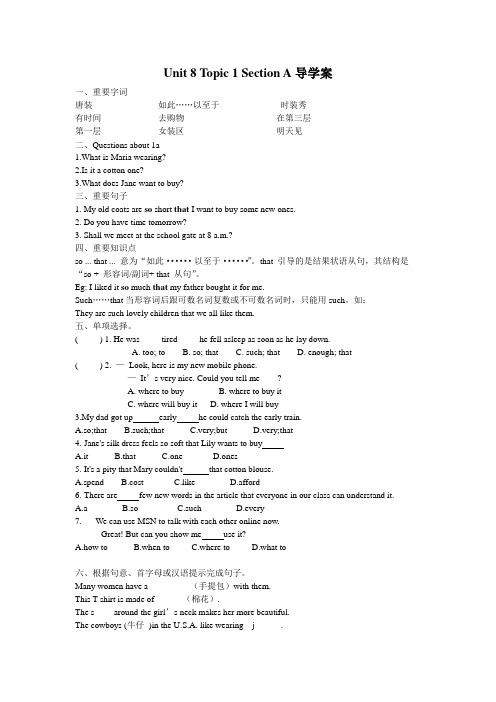
一、重要字词唐装如此……以至于时装秀有时间去购物在第三层第一层女装区明天见二、Questions about 1a1.What is Maria wearing?2.Is it a cotton one?3.What does Jane want to buy?三、重要句子1. My old coats are so short that I want to buy some new ones.2. Do you have time tomorrow?3. Shall we meet at the school gate at 8 a.m.?四、重要知识点so ... that ... 意为“如此······以至于······”。
that 引导的是结果状语从句,其结构是“so + 形容词/副词+ that 从句”。
Eg: I liked it so much that my father bought it for me.Such……that当形容词后跟可数名词复数或不可数名词时,只能用such。
如:They are such lovely children that we all like them.五、单项选择。
( ) 1. He was ____ tired ____ he fell asleep as soon as he lay down.A. too; toB. so; thatC. such; thatD. enough; that( ) 2. —Look, here is my new mobile phone.—It’s very nice. Could you tell me____?A. where to buyB. where to buy itC. where will buy itD. where I will buy3.My dad got up early he could catch the early train.A.so;thatB.such;thatC.very;butD.very;that4.Jane's silk dress feels so soft that Lily wants to buyA.itB.thatC.oneD.ones5.It's a pity that Mary couldn't that cotton blouse.A.spendB.costC.likeD.afford6.There are few new words in the article that everyone in our class can understand it.A.aB.soC.suchD.every7.----We can use MSN to talk with each other online now.------Great! But can you show me use it?A.how toB.when toC.where toD.what to六、根据句意、首字母或汉语提示完成句子。
仁爱英语八上导学案

Unit 1 Playing SportsThe school sports meet is coming.Section A导学案Teaching objectives: talk about school sports meet.the future tense with “will”.Key points : Objective1&2Difficult point: Objective2Step1 导入Lead inLet's talkWhat are you going to do this weekend?Why ?Great! I will come to cheer you on!Will you take part in it?Step2 呈现Presentation Phrases &Sentences1为某人加油2参加,加入某项活动(三种)3 跳高4跳远5为…做准备6接力赛7一双跑步鞋8谈论某事9某人第一次做某事 1 0运动会11男子800米赛跑12与某人交朋友13校园运动会将要来了。
14你将会参加哪一项运动会?男子800米赛跑。
15我将会参加跳高和跳远。
16这是我第一次参加跳高比赛。
Step3 DiscussPractice 1a with your partnerDiscuss in groups and make a survey.Will you take part in school sports meet? What will you do ? Why?1.the sports meet/meeting运动会the boys' 800一meter race男子800米赛跑the long jump跳远the high jump跳高the relay race接力赛跑2.It's the/one's first/second/…time to do sth.3.make friends with sb.与某人交朋友。
Unit8_When_is_your_birthday导学案
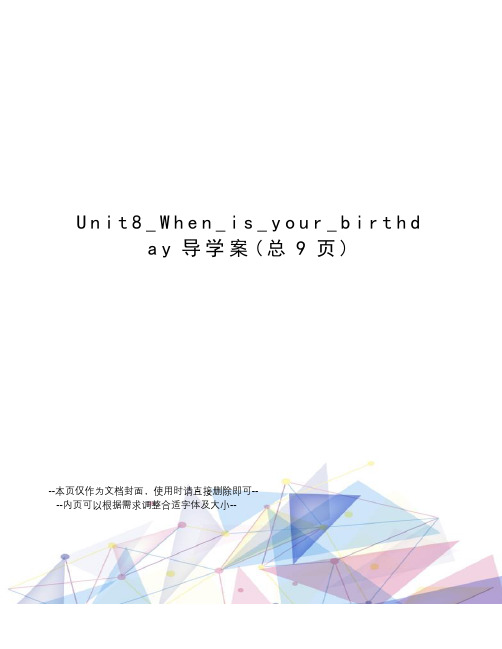
U n i t8_W h e n_i s_y o u r_b i r t h da y导学案(总9页)--本页仅作为文档封面,使用时请直接删除即可----内页可以根据需求调整合适字体及大小--Unit8 When is your birthday?第1课时Section A (1a—1c) (P43)【学习目标】1.掌握本课14个单词:when, month, January, February, March,April, May, June, July, August, September, October,November, December,2.会识别序数词。
3.学会句型When is your birthday 以及回答My birthday is.../It’s ……【学习重点、难点】学会询问他人生日的句型.【学习过程】一、预习准备熟练读写本课单词及短语1.个人自读、跟读1a录音,记忆本课单词及短语2.小组互相检查读写情况二、预习反馈1、根据汉语写出下列英语单词并展示什么时候,何时______, 月_____________2、翻译月份并写出其缩写形式。
比一比,看谁做得又快又准。
一月 _______ 二月_________ 三月_________ 四月________五月________ 六月________ 七月_________ 八月__________九月_______ 十月________ 十一月_________ 十二月__________三、合作学习1、写出下列数字的序数词形式:1 ______2 ______3 ________ 4______ 5______6______ 7_____ 8_________ 9______ 10______2、写出下列日期5月5号___________ 4月8号_______________3月4号______________3、通过使用句型以及回答学会询问他人的生日1).听录音,完成1a及1b。
最新人教版七年级上册英语精品导学案Unit 8

Unit 8When is your birthday?Section A (1a—2e)【自主预习·探新知】Ⅰ. 英汉互译,了解本课重点短语1.在六月三日2.生日快乐3.多大4.在八月5. at three6. see youⅡ. 完成句子,明确本课重点句型1.——你的生日是什么时候?——是1月5号。
—your birthday?—January 5th.2.我的生日是6月3号。
My birthday June 3rd. 3.——嗨,艾伦。
生日快乐!——谢谢你,比尔。
—Hi, Alan. !—Thank you, Bill.4.——那么,你多大了,艾伦?——我十二岁。
—So, ,Alan?—twelve.5.你想来参加我的生日聚会吗?Do you want to my birthday party?【合作探究·破疑难】【要点突破】1. when adv. (疑问副词)什么时候观察思考阅读下面的句子,思考并完成后面的探究总结—When is your birthday, Mike?迈克,你的生日是什么时候?—My birthday is on June 3rd.我的生日是6月3号。
(教材第43页) —When/What time do you get up?你什么时候/几点起床?—I usually get up at 6:30. 我通常六点半起床。
探究总结when与what time的用法辨析(1) 意为“什么时候;何时”,可对年、月、日进行提问;也可以提问具体时刻,此时相当于what time。
(2) 意为“几点;什么时间”,仅对具体时刻进行提问。
对点训练①My father’s birthday is on May 8th. (对画线部分提问)your father’s birthday?②They go to school at 7:00. (对画线部分提问)do they go to school?2. on prep.在(某一天)观察思考阅读下面的句子,体会句中介词的用法My birthday is on May 2nd.我的生日是5月2号。
人教版八年级英语(上册)导学案(全册)
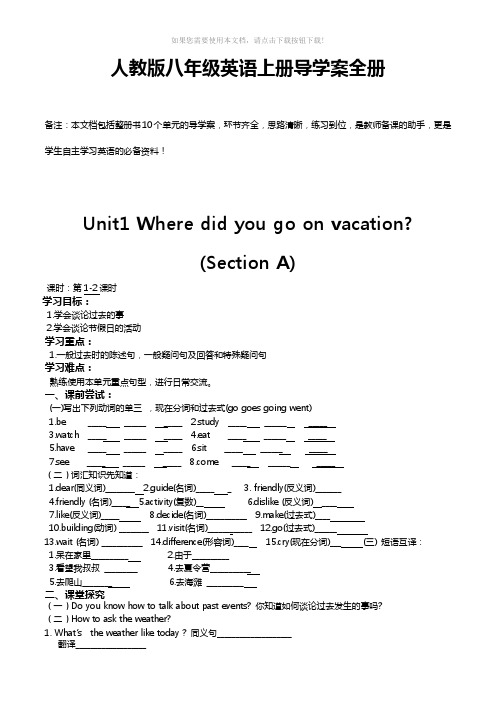
人教版八年级英语上册导学案全册备注:本文档包括整册书10个单元的导学案,环节齐全,思路清晰,练习到位,是教师备课的助手,更是学生自主学习英语的必备资料!Unit1 Where did you go on vacation?(Section A)课时:第1-2课时学习目标:1.学会谈论过去的事2.学会谈论节假日的活动学习重点:1.一般过去时的陈述句,一般疑问句及回答和特殊疑问句学习难点:熟练使用本单元重点句型,进行日常交流。
一、课前尝试:(一)写出下列动词的单三,现在分词和过去式(go goes going went)1.be _____ ______ _____2.study _____ ______ _____3.watch _____ ______ _____4.eat _____ ______ _____5.have _____ ______ _____6.sit _____ ______ _____7.see _____ ______ _____ e _____ ______ _____(二)词汇知识先知道:1.dear(同义词)________2.guide(名词)_____ _3. friendly(反义词)_______4.friendly (名词)_____5.activity(复数)__6.dislike (反义词) ____7.like(反义词)_____ 8.decide(名词)___________ 9.make(过去式)____10.building(动词) ________ 11.visit(名词)____________ 12.go(过去式)______13.wait (名词) ___________ 14.difference(形容词)____ 15.cry(现在分词)___ (三) 短语互译:1.呆在家里__________2.由于__________3.看望我叔叔_________4.去夏令营___________5.去爬山________6.去海滩__________二、课堂探究(一)Do you know how to talk about past events? 你知道如何谈论过去发生的事吗?(二)How to ask the weather?1. What’s the weather like today ? 同义句____________________翻译___________________2. What was the weather like yesterday? 同义句________________翻译___________________(三)T o talk about“What did you do on vacation?”(四)用所给词的适当形式填空1. Jim and Bob ___________ (come) to China last month.2. LiLei _________________(not go) to bed until 12 o’clock last night.So he ______ (get ) up late.3. Anna __________ (read) English yesterday morning.4. There _________ (be) no one here a moment ago.5. I ___________ (call) Lucy this morning.6. I listened but ___________ (hear) nothing.7. Mary ___________ (begin) to learn Chinese last year.8. Last week we _________ (pick) many apples on the farm.三、课后检测:(一)用所给词的适当形式填空1. Jack ______ (be) often late for school last term.2. It was ______ (rain) yesterday but it is sunny today.3. We have great fun _______ (learn) English.4. The dog made the baby ________ (cry).5. Can you help me ________ (study) English?6. What ______ you _______last night? (do)7. We ______(go) to the museum yesterday. It was _____(crowd).8. Lucy _______(write) two letters to her friends two days ago.(二)认真阅读下列句子, 选出最佳答案.( )1.How __________ your vacation? - It was pretty good.A. wasB. wereC. didD. is( )2.Where __________ they go yesterday? They went to the Summer Palace.A. areB. doC. didD. were( )3. --- Where did you go on vacation? I __________ my grandma.A. visitB. visitedC. visitsD. am visiting( )4.Betty stayed at home and __________ for the test last weekend.A. studyB. studyedC. studied D studies四、作业设计:单项选择()1.The boys are having great fun ______ in the waves.A.play B.to play C.played D.playing()2.Thank you very much for _________us so well.A.teachB. teachingC. teachesD. taught()3. How’s the weather in Shanghai ? _________.A. It raining.B. It is rain C .It is rainy. D. It rainy.()4.It has five _______ years of history.A. thousand B.thousands C.thousand of D.thousands of ()5.—When _______ a sports meeting? ---Last Monday.A. had you B.do you have C.did you have D.will you have()6. How is it going? ______.A. It's sunny. B.It's hot. C.It's right. D.It's pretty good()7.Listen! Who ________?A. sings so wellB. is sing so wellC. is singing so wellD. singing so well( ) 8. “You are a very beautiful girl.” “________”A. No, I’m not.B. Sorry, I don’t.C. Thank you.D. Yes, I do.( ) 9 He didn’t have_____ money for a taxi, ______ he walked back to the hotel.A. any, andB. much, becauseC. any, soD. some, so( ) 10. On Sunday morning I helped my mother ____ the cooking.A. doB. to doingC. doesD. doing( ) 11.---__________ ? ---He did some reading at home.A. What does your father do yesterday eveningB .What does your brother do in the schoolC. What did your brother do over the weekendD. Where did your brother go last SundayUnit 1 Where did you go on vacation?(Section B)课时:第3-4课时学习目标:1.学会如何用一般过去时谈论发生在过去的事情学习重点:一般过去时学习难点:How to use keep,enough and such…that correctly学习过程:一、课前尝试:(一)英汉互译:(一)熟读Section B 3a,然后完成下列英汉互译1.发现某人正在做某事_______________2.丢失,失踪, 迷路____________________3.帮助某人做某事__________________4.使得某人……做某事__________________5.决定去做某事___________________6.走回某地_______________________7. 打排球______________________ 8.干……事很愉快__________________9.记日记_______ 10.the Palace Museum_________(一)enough的用法(二)1.so +形容词或者副词+that+从句意思是:如此...以致于结果状语从句2.such +a /an + 形容词+名词+that+从句,当名次是不可数或者复数时,用such +形容词+不可数名词或者复数+that+从句Those are such beautiful flowers that we all like them.3.too+形容词或者副词+to do sth 意思是:太...而不能The boy is too young to carry the box.4.形容词/副词+enough +to do sth 意思是:...足够去做某事The boy is old enough to go to school.实战演练: 同义句转换1.This is so heavy a box that I can't carry it2.This is a heavy box I can't carry it3.This box is heavy me carry4.This box isn't carry三、课后检测:(一)根据所给句意及首字母提示完成下列单词拼写使句意通顺完整。
unit8How do you make a banana milk shake 导学案(可打印修改
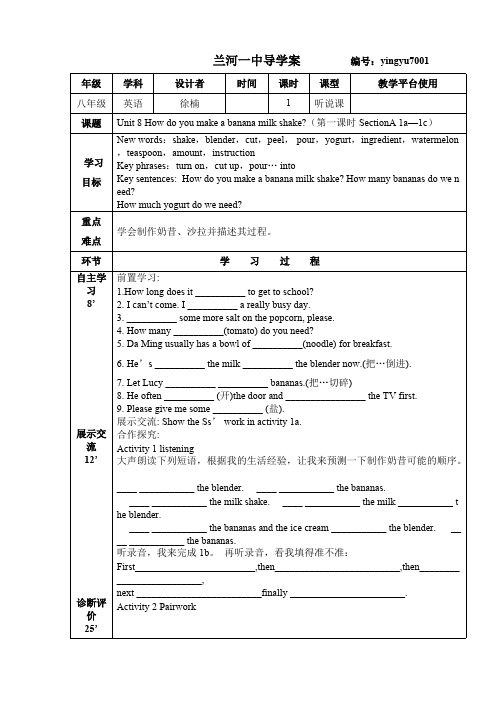
兰河一中导学案编号:yingyu7001评价与反思:兰河一中导学案编号:yingyu7002评价与反思:兰河一中导学案编号:yingyu7003年级学科设计者时间课时课型教学平台使用八年级英语徐楠3新课课题Unit 8 How do you make a banana milk shake?(第三课时SectionA 3a—3d)学习目标1、步骤词汇:first,next,then,finally动作词汇:peel,cut up,pour,turn on,mix up,add to,put 可数名词与不可数名词:(yogurt,popcorn,salt)2、如何制作奶昔和沙拉重点难点学祈使句 / 可数名词和不可数名词How much / How many引导的特殊疑问句环节习过程自主学习学习过程1. 自主学习1a里面的单词。
a. 找出新单词,边读边写两遍。
b. 熟悉词义,完成1a .2. 熟读1b中句子。
3. 自主练习1c中的对话, 初步掌握句型:—How do you make a milk shake? —Peel the banana….( 注意:1.熟记制作香蕉奶昔的步骤和需要用的动词短语.2. turn on 打开(电器等的电源)。
其反义词是turn off关上。
这种由“动词+副词”构成的短语中,当宾语是名词时,可置于动副词短语后,也可以在动词和副词之间。
如:turn on the TV =turn the TV on .但当宾语是代词时,则只能放在动词和副词之间。
如:turn it on绝不能说turn on it ).合作探究1.小组讨论并检查1a 的答案。
2.听听力,完成1b.2a,2b.3.分组练习1c,2c的对话,..点拨提升I根据汉语意思完成下列句子。
1.首先剥开三根香蕉。
, __________________ three bananas.2.然后将苹果切碎。
Then _________ the apples _______________ .3.你怎样做香蕉奶昔?_________do you _________a banana ____________ .4.最后,将奶昔倒进一个杯子里。
Unit 8 How do you make a banana milk shake第一课时导学案
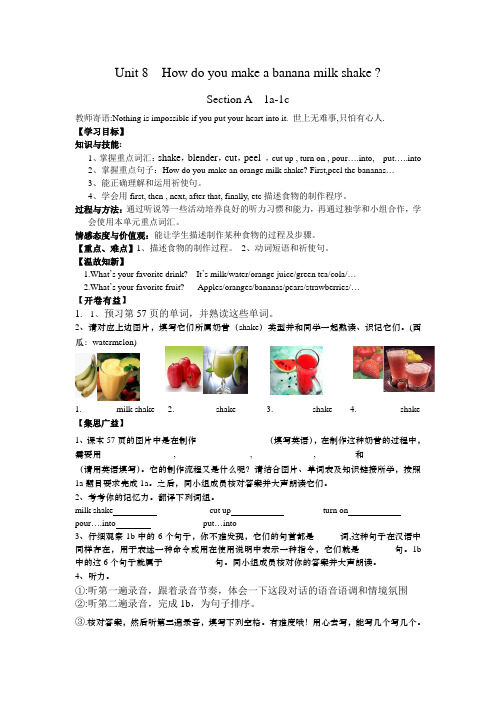
Unit 8 How do you make a banana milk shake ?Section A 1a-1c教师寄语:Nothing is impossible if you put your heart into it. 世上无难事,只怕有心人.【学习目标】知识与技能:1、掌握重点词汇:shake,blender,cut,peel,cut up , turn on , pour….into, put…..into2、掌握重点句子:How do you make an orange milk shake? First,peel the bananas…3、能正确理解和运用祈使句。
4、学会用first, then , next, after that, finally, etc描述食物的制作程序。
过程与方法:通过听说等一些活动培养良好的听力习惯和能力,再通过独学和小组合作,学会使用本单元重点词汇。
情感态度与价值观:能让学生描述制作某种食物的过程及步骤。
【重点、难点】1、描述食物的制作过程。
2、动词短语和祈使句。
【温故知新】1.What’s your favorite drink? It’s milk/water/orange juice/green tea/cola/…2.What’s your favorite fruit? Apples/oranges/bananas/pears/strawberries/…【开卷有益】1.1、预习第57页的单词,并熟读这些单词。
2、请对应上边图片,填写它们所属奶昔(shake)类型并和同学一起熟读、识记它们。
(西瓜:watermelon)1.________milk shake2._________ shake3._________shake4.__________shake 【集思广益】1、课本57页的图片中是在制作________________(填写英语),在制作这种奶昔的过程中,需要用________________ ,_________________,______________,_________和____________(请用英语填写)。
八年级英语上册第五单元SectionA第1课时(导学案)
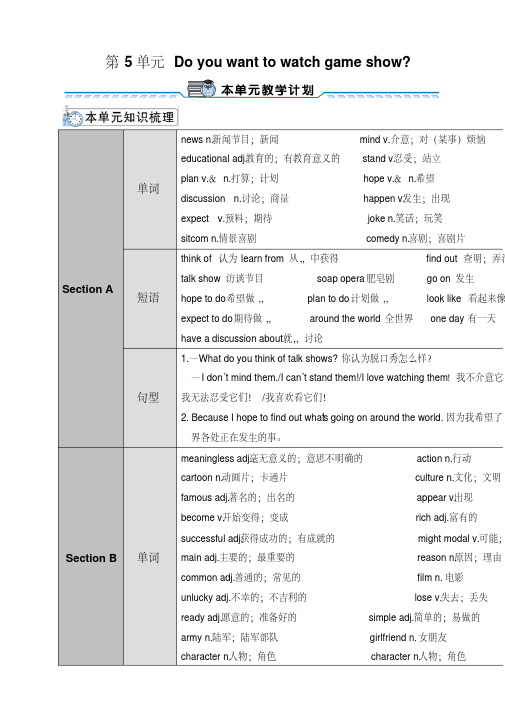
第5单元Do you want to watch game show?Section A 单词news n.新闻节目;新闻mind v.介意;对(某事)烦恼educational adj.教育的;有教育意义的stand v.忍受;站立plan v.&n.打算;计划hope v.&n.希望discussion n.讨论;商量happen v.发生;出现expect v.预料;期待joke n.笑话;玩笑sitcom n.情景喜剧comedy n.喜剧;喜剧片短语think of 认为learn from 从,,中获得find out 查明;弄清talk show 访谈节目soap opera 肥皂剧go on 发生hope to do希望做,,plan to do计划做,,look like 看起来像expect to do期待做,,around the world 全世界one day 有一天have a discussion about 就,,讨论句型1.—What do you think of talk shows? 你认为脱口秀怎么样?—I don’t mind them./I can’t stand them!/I love watching them!我不介意它我无法忍受它们!/我喜欢看它们!2. Because I hope to find out what’s going on around the world. 因为我希望了界各处正在发生的事。
Section B 单词meaningless adj.毫无意义的;意思不明确的action n.行动cartoon n.动画片;卡通片culture n.文化;文明famous adj.著名的;出名的appear v.出现become v.开始变得;变成rich adj.富有的successful adj.获得成功的;有成就的might modal v.可能;main adj.主要的;最重要的reason n.原因;理由common adj.普通的;常见的film n.电影unlucky adj.不幸的;不吉利的lose v.失去;丢失ready adj.愿意的;准备好的simple adj.简单的;易做的army n.陆军;陆军部队girlfriend n.女朋友character n.人物;角色character n.人物;角色短语be ready to 愿意(做某事)dress up 装扮;乔装打扮as famous as与,,一样有名let sb.do sth. 让某人做某事such as例如 a pair of一双;一对come out出版;发行try one’s best to do sth. 尽力做某句型1. In his early films, Mickey was unlucky and had many problems such as losi house or girlfriend, Minnie. 在他的早期影片里,米老鼠是不幸的,他面临问题,比如失去自己的房子和女朋友米妮。
七年级英语人教版导学案Unit 8 Is there a post office near here

Unit 8 Is there a post office near here?Section A(1a-2c)导学案(第一课时)【学习目标】A:知识与技能目标:1、知识与能力:(1)掌握本课时的单词及短语,并能使用这些新词短语造简单的句子(2)掌握指路和问路的问句和答语,能跟有礼貌地问路、指路。
(3)掌握本节课所涉及的重点单词和短语。
B:过程与方法目标:自主预习,小组交流,合作探究。
C:情感态度与价值观:通过学会如何有礼貌地问路,指路,培养学生文明交往及助人为乐的习惯【预习重点】There be +名词+地点(事物) “某处有某物”【学习过程】一、课前预习1. 识记本课时的新词,并翻译下列短语restaurant__________ post office__________ police station__________ pay phone__________ hospital__________ there is_______________ there are__________ across from__________ between…and_____ next to___________ in front of___________ behind________across from__________ far from_________ No problem_______2. 能用Is there…? Are there…? 句型就周围的地点进行问答。
3. 两人一组,利用上面的名词和介词来练习下面的对话.A: Is there a hospital near here?B: Yes, there is./No, there isn’t. … …二、课上活动(一)听力训练(1a&1b)1. 听前。
(1)看图片,回答下列问题。
What can you see in the picture? _______________________________Where is it ?(2)处理1a。
导学案unit8 (1)
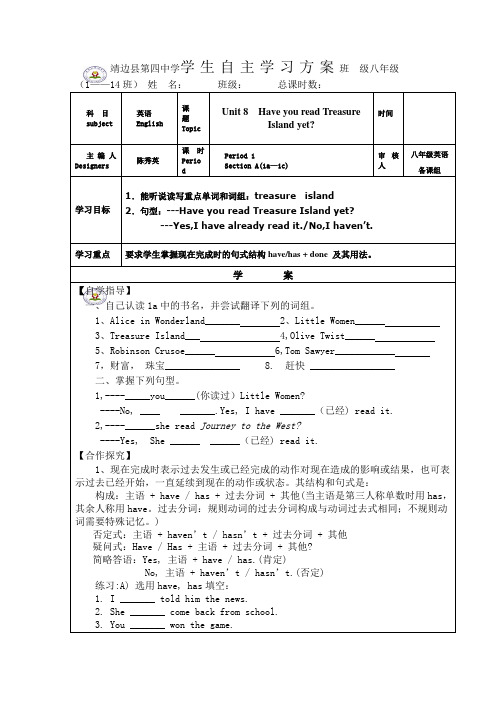
靖边县第四中学学生自主学习方案班级八年级(1——14班)姓名:班级:总课时数:科目subject 英语English课题TopicUnit 8 Have you read TreasureIsland yet?时间主编人Designers 陈秀英课时PeriodPeriod 1Section A(1a—1c)审核人八年级英语备课组学习目标1.能听说读写重点单词和词组:treasure island2.句型:---Have you read Treasure Island yet?---Yes,I have already read it./No,I haven’t.学习重点要求学生掌握现在完成时的句式结构have/has + done 及其用法。
学案【自学指导】一、自己认读1a中的书名,并尝试翻译下列的词组。
1、Alice in Wonderland_______2、Little Women______3、Treasure Island___ 4,Olive Twist______5、Robinson Crusoe______ 6,Tom Sawyer____________7,财富,珠宝_______________ 8. 赶快 _________________二、掌握下列句型。
1,----_____you______(你读过)Little Women?----No, ____ _______.Yes, I have _______(已经) read it.2,----______she read Journey to the West?----Yes, She ______ ______(已经) read it.【合作探究】1、现在完成时表示过去发生或已经完成的动作对现在造成的影响或结果,也可表示过去已经开始,一直延续到现在的动作或状态。
其结构和句式是:构成:主语 + have / has + 过去分词 + 其他(当主语是第三人称单数时用has,其余人称用have。
七下导学案Unit 8 Is there a post office near here
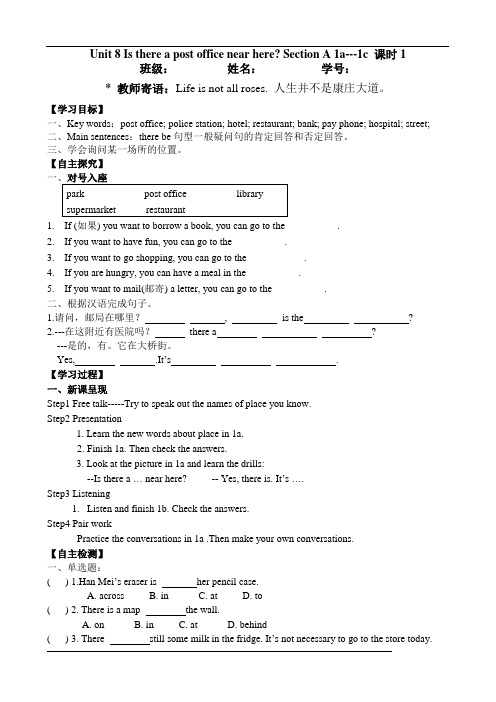
Unit 8 Is there a post office near here? Section A 1a---1c 课时1班级:姓名:学号:* 教师寄语:Life is not all roses. 人生并不是康庄大道。
【学习目标】一、Key words:post office; police station; hotel; restaurant; bank; pay phone; hospital; street;二、Main sentences:there be句型一般疑问句的肯定回答和否定回答。
三、学会询问某一场所的位置。
【自主探究】二、根据汉语完成句子。
1.请问,邮局在哪里?, is the ?2.---在这附近有医院吗?there a ?---是的,有。
它在大桥街。
Yes, .It’s .【学习过程】一、新课呈现Step1 Free talk-----Try to speak out the names of place you know.Step2 Presentation1. Learn the new words about place in 1a.2. Finish 1a. Then check the answers.3. Look at the picture in 1a and learn the drills:--Is there a … near here? -- Yes, there is. It’s ….Step3 Listening1.Listen and finish 1b. Check the answers.Step4 Pair workPractice the conversations in 1a .Then make your own conversations.【自主检测】一、单选题:( ) 1.Han Mei’s eraser is her pencil case.A. acrossB. inC. atD. to( ) 2. There is a map the wall.A. onB. inC. atD. behind( ) 3. There still some milk in the fridge. It’s not necessary to go to the store today.A. amB. isC. areD. be( ) 4. There a sheep and two cows on the farm eating grass.A. areB. isC. haveD. has( ) 5. My father’s store is Long Street.A. ofB. atC. fromD. on( ) 6. ---Is there a post office near here? --- .A. Yes, it isB. No, there is.C. Yes, there isD. No, it isn’t二、Match the English words with the Chinese words. 中英文词汇配对。
八年级英语下册第八单元导学案第一课时
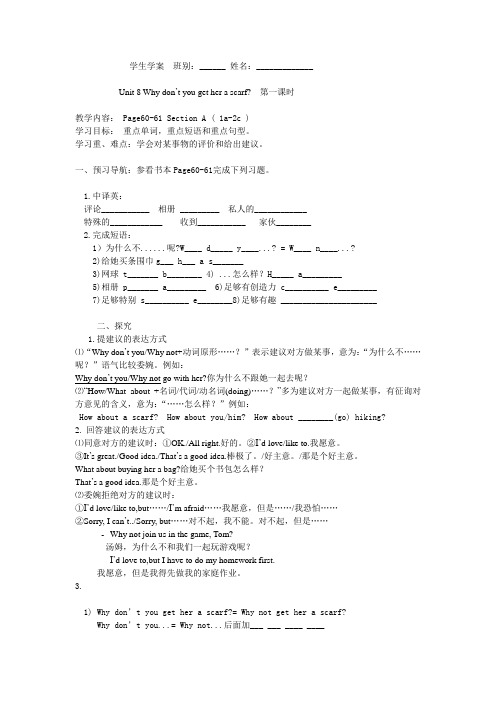
学生学案班别:______ 姓名:_____________Unit 8 Why don’t you get her a scarf? 第一课时教学内容: Page60-61 Section A ( 1a-2c )学习目标:重点单词,重点短语和重点句型。
学习重、难点:学会对某事物的评价和给出建议。
一、预习导航:参看书本Page60-61完成下列习题。
1.中译英:评论___________ 相册 _________ 私人的____________特殊的____________ 收到___________ 家伙________2.完成短语:1)为什么不......呢?W____ d_____ y____...? = W____ n____...?2)给她买条围巾g___ h___ a s_______3)网球 t_______ b________ 4) ...怎么样?H_____ a_________5)相册 p_______ a_________ 6)足够有创造力 c__________ e_________7)足够特别 s__________ e________8)足够有趣 ______________________二、探究1.提建议的表达方式⑴“Why don’t you/Why not+动词原形……?”表示建议对方做某事,意为:“为什么不……呢?”语气比较委婉。
例如:Why don’t you/Why not go with her?你为什么不跟她一起去呢?⑵“How/What about +名词/代词/动名词(doing)……?”多为建议对方一起做某事,有征询对方意见的含义,意为:“……怎么样?”例如:How about a scarf? How about you/him? How about ________(go) hiking?2. 回答建议的表达方式⑴同意对方的建议时:①OK./All right.好的。
新目标七年级上导学案unit8
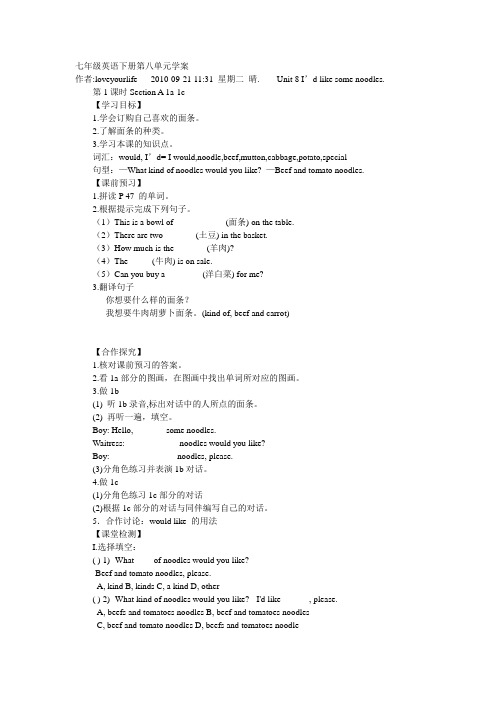
七年级英语下册第八单元学案作者:loveyourlife 2010-09-21 11:31 星期二晴.Unit 8 I’d like some noodles.第1课时Section A 1a-1c【学习目标】1.学会订购自己喜欢的面条。
2.了解面条的种类。
3.学习本课的知识点。
词汇:would, I’d= I would,noodle,beef,mutton,cabbage,potato,special句型:—What kind of noodles would you like? —Beef and tomato noodles.【课前预习】1.拼读P 47 的单词。
2.根据提示完成下列句子。
(1)This is a bowl of____________(面条) on the table.(2)There are two _______(土豆) in the basket.(3)How much is the _______(羊肉)?(4)The _____(牛肉) is on sale.(5)Can you buy a ________(洋白菜) for me?3.翻译句子--- 你想要什么样的面条?--- 我想要牛肉胡萝卜面条。
(kind of, beef and carrot)【合作探究】1.核对课前预习的答案。
2.看1a部分的图画,在图画中找出单词所对应的图画。
3.做1b(1) 听1b录音,标出对话中的人所点的面条。
(2) 再听一遍,填空。
Boy: Hello, _______some noodles.Waitress: ____________noodles would you like?Boy: _______________noodles, please.(3)分角色练习并表演1b对话。
4.做1c(1)分角色练习1c部分的对话(2)根据1c部分的对话与同伴编写自己的对话。
5.合作讨论:would like 的用法【课堂检测】I.选择填空:( ) 1) -What ____of noodles would you like?-Beef and tomato noodles, please.A, kind B, kinds C, a kind D, other( ) 2) -What kind of noodles would you like? - I'd like ______, please.A, beefs and tomatoes noodles B, beef and tomatoes noodlesC, beef and tomato noodles D, beefs and tomatoes noodle( ) 3) I _______ bananas very much, but now I_______ an apple.A, would like; like B, like; likeC, would like; would like D, like; would like( ) 4) - _____________? - Yes, I'd like some chicken.A, Where are you B, What do you doC, Can I help you D, How can you get the milk( ) 5) Some tomatoes _____in the bag. Some beef______ on the table.A, is; is B, are; are C, are; is D, is; areII.按要求改写句子。
最新人教版英语初中八年级上册Unit 8 公开课导学案
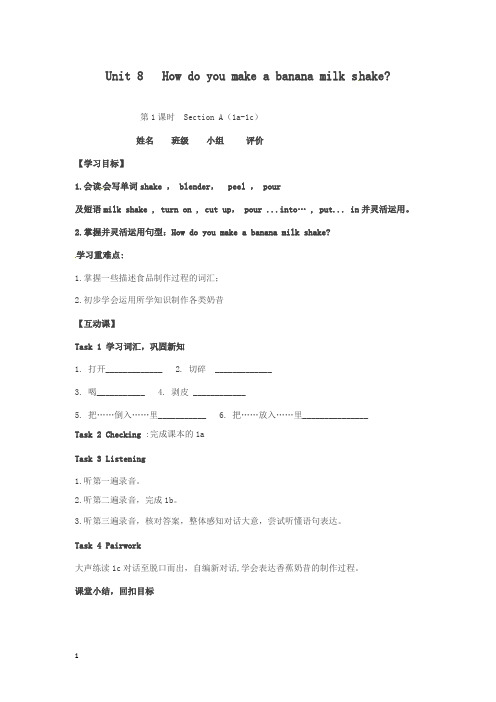
Unit 8 How do you make a banana milk shake?第1课时 Section A(1a-1c)姓名班级小组评价【学习目标】1.会读会写单词shake , blender, peel , pour及短语milk shake , turn on , cut up, pour ...into… , put... in并灵活运用。
2.掌握并灵活运用句型:How do you make a banana milk shake?学习重难点:1.掌握一些描述食品制作过程的词汇;2.初步学会运用所学知识制作各类奶昔【互动课】Task 1 学习词汇,巩固新知1. 打开_____________2. 切碎 _____________3. 喝___________4. 剥皮 ____________5. 把……倒入……里___________6. 把……放入……里_______________Task 2 Checking :完成课本的1aTask 3 Listening1.听第一遍录音。
2.听第二遍录音,完成1b。
3.听第三遍录音,核对答案,整体感知对话大意,尝试听懂语句表达。
Task 4 Pairwork大声练读1c对话至脱口而出,自编新对话,学会表达香蕉奶昔的制作过程。
课堂小结,回扣目标Unit 8 How do you make a banana milk shake?第1课时 Section A(1a-1c)姓名班级小组评价一.根据句意及汉语提示完成单词。
(3分)1.Please pour the milk into the _______ (食物搅拌器).2.Before eating the fruit , we should wash and _____ (削皮) it .3.Don’t _______(倒) wastes into the river.二.单项选择。
- 1、下载文档前请自行甄别文档内容的完整性,平台不提供额外的编辑、内容补充、找答案等附加服务。
- 2、"仅部分预览"的文档,不可在线预览部分如存在完整性等问题,可反馈申请退款(可完整预览的文档不适用该条件!)。
- 3、如文档侵犯您的权益,请联系客服反馈,我们会尽快为您处理(人工客服工作时间:9:00-18:30)。
第8单元
It must belong to Carla.
Section A 单词
whose adj.& pron.谁的truck n.卡车;货车
picnic n.野餐rabbit n.兔;野兔
attend v.出席;参加valuable adj.贵重的;宝贵的;很有用的
pink adj.粉红色的n.粉红色anybody pron.任何人
noise n.声音;噪音policeman n.(pl. policemen) 男警察
wolf n.狼laboratory n.实验室
coat n.外套;外衣sleepy adj.困倦的;瞌睡的
outdoors adv.在户外;在野外uneasy adj.担心的;不安的
happening n.事件;发生的事情(常指不寻常的)
短语
belong to属于pop music流行音乐pick up 拿起;捡起
run away 逃跑;逃走have no idea 不知道take a shower 洗淋浴
句型
1.—Whose volleyball is this? 这是谁的排球?
—It must be Carla’s. She loves volleyball.它肯定是卡拉的。
她喜欢排球。
2.—Whose hair band is this? 这是谁的发带?
—It could be Mei’s hair band. Or it might belong to Linda. They both have long hair.
它可能是梅的发带。
也可能是属于琳达的。
她们都有长头发。
Section B 单词land v.着陆;降落suit n.西服;套装v.适合express v.表示;表达circle n.圆圈v.圈出
leader n.领导;领袖receive v.接待;接受;收到Britain(=Great Britain) 大不列颠medical adj.医疗的;医学的purpose n.目的;目标position n.位置;地方prevent v.阻止;阻挠energy n.力量;精力victory n.胜利;成功enemy n.敌人;仇人period n.一段时间;时期alien n.外星人
mystery n.
奥秘;神秘事物ancestor n.祖宗;祖先
midsummer n.仲夏;中夏burial n.埋葬;安葬historian n.历史学家;史学工作者
honor(=honour)v.尊重;表示敬意n.荣幸;荣誉
短语run after 追逐;追赶at the same time 同时;一起
point out 指出;指明prevent sb.from doing sth.阻止某人做某事a long period of time 很长一段时间communicate with sb.与某人交流/练习
in a certain way以某种方式
句型1. People like to go to this place especially in June as they want to see the sun rising on the longest day of the year.人们尤其喜欢在六月去这个地方,因为他们想在一年中最长的一天看日出。
2. For many years , historians believed Stonehenge was a temple where ancient leaders tried to communicate with the gods.
多年以来,历史学家们认为巨石阵是古代首领用来与神灵沟通的一座神庙。
语法情态动词表推测
知识目标掌握情态动词表推测的用法。
能力目标能听懂关于“物品归属”的对话,并能与他人谈论此话题;能读懂有关描述物品归属的文章,并能就某物的归属进行推测表达。
情感目标根据周围事物传达的信息、背景等作出合乎逻辑的推理和判断。
本单元建议5课时
Section A(1a~2d)……………………………………………………………………………….. ………….1课时Section A(3a~4c)…………………………………………………………………………………………..1课时Section B(1a~1d)……………………………………………………………………………………….1课时
Section B(2a~2e)…………………………………………………………………………………………1课时Section B(3a~Self Check)………………………………………………………………………………..1课时
词汇短语:主要采用在实际操作中运用的方法。
基本句子:采用多媒体展示和交际法。
情态动词表推测——采用归纳法和举例法。
Section A 第1课时(1a~2d)
类别学习重点
重点单词whose, truck, rabbit, attend, valuable, pink, picnic, anybody
重点短语belong to, listen to, pick up
重点句式
1. Whose volleyball is this?
2. J.K. Rowling is her favorite writer.
3. It must belong to Carla.
课
前
预
习
写一写
1.谁的whose
2.野餐picnic
3.出席;参加attend
4.贵重的;很有用的valuable
译一译
1.属于belong to
2.听……listen to
3.拾起pick up
背一背
1.这个发带可能是琳达的。
The hair band might belong to Linda.
2.我想一定有人捡到它了。
I think somebody must have picked it up.
新课导入
The teacher takes some of the things of the students to hide somewhere before having the class. When class begins , take out the things and let the students guess the owner of the book by asking: Excuse me, whose … is this? Help the students answer like: It must be Wang Hao’s , because his name is on the book.
新课展示【完成教材1a~2d的教学任务】
1.1a学生看本节图片,把看到的物品写在下列表格中的专栏里。
2.1b听1b录音,把人、物品和推断理由配对。
3.1c学生练习图中的对话,然后用1b表格中的信息编对话。
4.2a鲍勃和安娜在公园里发现了一个书包。
学生听录音,把背包里的物品写下来。
5.2b再听录音,根据录音内容填空。
6.2c学生用2a和2b的材料编对话。
7.2d处理学生预习后的重难点,然后学生分角色表演对话。
【语法提要】
1.belong to
belong to意为“属于;为……所拥有”。
belong to没有被动语态,也不能用于进行时态。
belong to 后可接名词或代词作宾语,不能接物主代词,也不能接名词所有格。
如:
The blue sweater belongs to Li Ming. His mother bought it for him yesterday.这件蓝色的毛衣是李
明的,他的妈妈昨天给他买的。
The boy belongs to the singing group of Grade One.这个男孩是一年级演唱队的队员。
That new bike in the corner belongs to Helen.角落里那辆新自行车是海伦的。
2.must
(1)must为情态动词,无人称和数的变化,后接动词原形。
注意在回答must引起的一般疑问句时,否定式常用needn’t或don’t have to,意为“没必要”,而mustn’t表示“不准;禁止”。
如:
—Must I finish the work on time?我必须按时完成工作吗?
—Yes, you must./No, you needn’t/don’t have to.是的,你必须。
/不,你不必。
